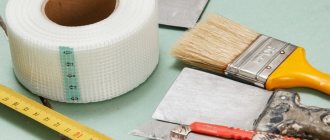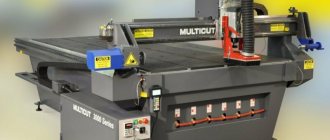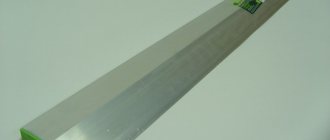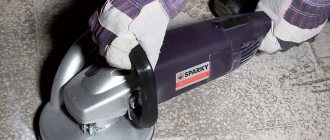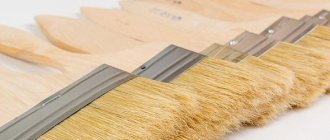Plastering the walls is the final stage of interior finishing work. The final result – gluing or painting – depends on the quality of the work performed. The ideal evenness and smoothness of surfaces is achieved not only by the professionalism of the master, but also by the selected tools, one of which is a grater, with which the walls and ceiling are sanded to perfect smoothness. How to choose the right tool? The editors of the Yanashla website invite readers to familiarize themselves with the rating of the best graters for plastering work for 2022.
What is it for?
The functionality of the tool is to make the surface smooth before final finishing - for grinding plaster.
Previously, homemade structures were used for such purposes. They were a wooden beam with a flat surface with a handle attached to it. A significant drawback was that the material quickly failed because it absorbed moisture and could not withstand temperature changes.
Now you can choose a model from different materials, and they have impeccable performance characteristics:
- convenient design;
- light weight;
- moisture resistance;
- durability;
- large selection of models in sizes and materials;
- low cost.
Also, to level the plaster layer, construction tools such as a trowel and a construction float are used. A trowel, or trowel, is narrower and longer; it is more suitable for removing imperfections and eliminating excess mortar, while a trowel is more suitable for completely rubbing the plaster until an ideal smooth surface is achieved. What are construction floats used for? Their functionality includes both the creation of smooth surfaces and the formation of texture on decorative plaster. In addition, they can be used to create patterns on the walls due to the textured sole.
Types of plaster floats
Today you can find different types of this tool. This is due to the development of technology, which makes life easier for builders. The main types are as follows:
- wooden;
- foam;
- polyurethane;
- plastic;
- rubber;
- latex;
- spongy;
- metal.
As you can see, the main difference between plaster floats is the material from which the polishing surface is made. They all have the same appearance - a handle with a surface polishing material attached to it. The principle of operation of each of them is also basically the same, but there are still differences that must be taken into account before purchasing and starting work.
What are they and which one is better to buy?
Externally, all devices are similar - a plane with a handle, as is the principle of their operation. The classification is based on what material they are made of. According to buyers, polyurethane, wood, foam, plastic and sponge are the most popular models.
Types and features of tools for plastering work:
- Sponge ones are intended primarily for decorative finishing. With their help, images can be obtained on the surface thanks to the spongy material on the grinding part. The body is made of aluminum or polyurethane, which ensures the light weight of the product. A grater is not suitable for compacting the solution or giving a perfectly smooth surface.
- Wooden devices are popular due to their low price and light weight. But, given their fragility and budget cost, it is worth purchasing several pieces if this is the material that is preferred. The short service life is due to the fact that wood, absorbing moisture, gains weight. As the sole dries, it begins to deform. In addition, the wooden surface is not resistant to abrasion, so its working qualities are quickly lost.
- Rubber work surface coatings are designed to work with epoxy compounds, as they do not harden with glue and are resistant to mechanical loads. Recommended for grouting tile joints.
- Metal ones are used to work with porous solutions, effectively compacting them, after which the surface is immediately ready for painting. As a result of using such a tool, the effect of so-called ironing appears - a water-repellent protective film is formed, and the surface is very smooth and glossy. This tool is also suitable for grouting rough plaster. The disadvantages of these models are their tendency to form corrosion and their relatively high price.
- The popularity of foam models is due to their light weight and low cost. But, despite the fact that they are made from hard foam, they are fragile. It is recommended for experienced craftsmen to purchase such devices, but even in this case, their long service life is not possible - the handle quickly breaks down. If handled correctly and carefully, these trowels are ideal for creating a smooth finish on gypsum and polymer plasters.
- Plastic ones are considered specialized tools and are recommended for experienced craftsmen. With their help, it is possible to flawlessly distribute the mixture over the wall, smooth out seams and irregularities. Their advantages include: corrosion resistance, light weight, ease of use. They are not used for distributing a thick layer of mortar, and due to their fragility they are suitable for one-time work. In addition, they are plastic and are not flexible, and when temperatures change, the product may break.
- Polyurethane is most in demand due to its performance characteristics:
- slight abrasion of the working surface;
- a light weight;
- wear resistance;
- strength;
- low price.
They are used when working with different solutions - thicker soles are suitable for applying and leveling gypsum and lime plasters, and thin ones for decorative plasters. The advantages include the strength of the material and the elimination of deformation even after a long service life. They are used to process large volumes of work.
Each type of grater has its own advantages and disadvantages, so when choosing, it is necessary to take into account the experience of the master, the amount of work during construction and the function of the tools needed to complete them.
Criterias of choice
What should you pay attention to so as not to make mistakes when choosing? The following parameters are important:
- The tool should fit comfortably in the hand, which is facilitated by the indentations for the fingers on the handle.
- The working surface must be smooth and level so as not to damage the coating during operation.
- Pay attention to the quality of the material.
- For a larger processing area, you need to choose a tool with a larger sole area.
- For easily accessible areas, it is preferable to use a grater with a long handle.
- If the final finishing stage involves painting, it is better to use a metal grater for polishing.
- Deteriorated wooden tools can be used to apply bark beetle type plaster.
What is grout?
Grouting is the final stage of plastering work, which consists of eliminating the smallest errors, leveling and smoothing the surface by rubbing the dried mortar with a special tool. When using decorative plaster, the main purpose of the grout is to form a certain relief of the working plane.
Applying a finishing layer of fine leveling plaster
Before grouting, a “covering” is applied to the base - the finishing layer of plaster mortar. The base layer, or primer, is very durable and therefore difficult to process, while the covering ensures uniform filling of uneven surfaces and maximum smoothness when grouting. Rub the plaster after the mortar has set, but before it dries completely.
Rub the cover
How to use
Although finishing work is considered labor-intensive, if you follow the recommendations, even a beginner can master it.
- When performing interior finishing, the process is divided into three stages - spraying, applying primer, and covering. The first two perform filling and supporting functions, and the third – decorating.
- When covering, you should rub the material using a tool over the surface to be treated. By lightly pressing the grater and evenly distributing the solution over the plane, smooth movements are made in the form of a figure eight, circles counterclockwise or up and down. At the same time, the mixture is compacted, which improves the final quality. Small areas should be treated sequentially. During the process, the sole of the instrument is moistened with water.
- Sanding is done on dried plaster after about 5 hours. Grouting is done with a construction float, the sole of which is covered with felt or felt with lint, which eliminates small particles and stains, and the surface is as smooth as possible.
- But even after following all the advice and having experience and skills, the master can detect nodules or depressions upon completion. To eliminate these shortcomings, you can use a grater with an abrasive mesh, which is attached to the body. Cell sizes and spray density may vary. Fine-mesh nozzles are used for grinding soft materials, coarse ones for hard ones.
- For exterior finishing, mixtures such as bark beetle are used, which are resistant to temperature changes and aggressive environmental influences. Work is carried out on stone, brick, concrete and plasterboard surfaces. Other techniques are used here - stretching the solution to obtain grooves or moving in a spiral to obtain the appropriate texture. The ornament will become visible only after complete drying. If necessary, you can make a small correction using a grater.
General principles of technology
The final stage of cladding is covering and grouting the plaster with floats. In some cases, smoothing is done instead of grouting, but the tool used is almost the same. The quality of the cladding depends not only on the tool; the composition used for finishing is of great importance. If you use a solution prepared by yourself, then the finishing layer is mixed with fine sand with normal fat content. Coarse sand will give a rough surface, suitable only for laying tiles.
We recommend: The best chainsaws - ratings, comparisons and reviews of the best models
The process of applying plaster.
Important: adding gypsum to lime mortar results in a decrease in strength. Excessive fat content of the composition will result in a large number of grinds and unbroken stripes; fat content is good for smoothing. Skinny compounds do not rub well and are not durable.
If you do not have fundamental knowledge in the field of preparing mortars, then it is better to use ready-made building mixtures. This will significantly save your time and effort. Because if the solution is prepared incorrectly, everything may have to be redone later.
The principle of working with building mixtures.
Grouting plaster with trowels can be done in 2 ways: in a circle and in a sweeping manner. By and large, both methods are parts of a general technology. The only difference is that if you don't require perfect quality, you can opt for round cutting. And for high-quality cladding, both technological methods are used.
Types of grout.
How to rub in a circle
The grater is taken in the hand and pressed tightly to the surface, circular movements are performed mainly counterclockwise. Thus, all elevations and tubercles on the plane are removed with the side of the tool. Small depressions will be filled with cut mortar and compacted to level the surface. The force with which the tool should be pressed is regulated arbitrarily and, as a rule, comes with experience. The instructions themselves are simple; on the more convex parts you should press harder. At depressions, the pressure weakens. As you work, solution will accumulate on the sides of the grater; it must be removed periodically. You should not wait until it flies around on its own, because you are in close proximity to the surface of the wall and the likelihood of the dried solution getting into your eyes is too high. You shouldn’t throw it away either; experienced specialists remove the mass with a wide spatula and immediately fill deep depressions or chips with it. Grouting plaster with floats is a rather long and painstaking process. Over time, the surface will dry out, making it harder to grout. In order to avoid these unpleasant moments, the wall must be constantly moistened with plain water. Professionals use a special “stone” brush for this purpose. With this technology, no matter how hard you try, circular marks from your tool will remain on the wall. If quality is not too important for a given room, for example, in a basement or utility room, then you can leave it that way. But to achieve an ideal result, you should go through the acceleration method.
The principle of operation of a grater on a hinge.
Mashing
This technology is used to achieve a uniform layer, without streaks; as a rule, such surfaces are suitable for painting. Take a cleaned grater, without any remaining mortar, and perform back-and-forth movements up and down, simultaneously pressing it against the wall.
Important: grouting is carried out on a damp surface. It is best to do this immediately after grouting in a circular manner, and do the work in parts, in sectors. Having rubbed no more than 1 m² in a circle, immediately rub this surface smoothly. An insufficiently wet surface is additionally wetted.
In addition to the fact that a perfectly straight tool is used for such work, its edges should be slightly rounded so that there are no scratches from the corners. According to building codes, walls in rooms with ceilings up to 4 m can have only 1 joint. This is quite easy to achieve. The work is performed in 2 strokes, the first from the ceiling to the level of the construction scaffolding, and the second from the border of the construction scaffolding to the floor. Such work should be started with a wooden or polyurethane tool, then to improve the quality of the grout, a trowel for plastering work with a felt or felt pad is used. To achieve a glossy effect, a metal plaster float is used before painting.
Sandpaper grater.
Smoothing the surface
Venetian plaster.
When using high-quality building mixtures and good tools, many specialists, after leveling the surface, immediately proceed to smoothing the surface, bypassing grouting. The tool used for this is almost the same. The most common economical option is a wooden trowel, covered with a sheet of soft, smooth rubber. On average, the size of the surface of the grater used for these purposes ranges from 60 to 100 cm. The rubber sheet can be solid or consist of several strips. But most importantly, it must wrap around the edges of the board and go up at least 20 mm, on all sides. For smoothing, a metal trowel can also be used to grout the plaster; in addition to directly ironing the cement coating, they are used for arranging a putty-free finish. Smoothing can only be done on a flat, damp surface. The process itself is reminiscent of smooth grouting, only smoothing is done in 2 directions. For walls, smoothing is first done in the vertical direction, after which the wall is smoothed horizontally. When performing work on the ceiling, the direction of sunlight from the window is taken into account. Initially, smoothing occurs across the sun's rays, after which it is smoothed parallel to the sun.
Textured plaster.
The video in this article shows the basics of grouting technology.
Where can I buy
Purchasing such equipment is not difficult - the product is available in any hardware store and is represented in a wide range. As a rule, purchases during repairs are quite large-scale, so a good alternative to going shopping is to order all the necessary tools online from an online store. The best manufacturers offer their products in this way, and when choosing, you can read the description and photo of the product and read customer reviews. You will also be able to purchase new items that have not yet hit store shelves.
To choose, you need to decide which model of material you need and which company is better. The best repair tools, according to customer opinions and reviews, are produced by Zubr, PU-TECH, DEXX, Stayer.
The best manufacturers
The popularity of models depends not only on ease of use, but also on the reputation of the manufacturer. In 2022, construction tools produced by the following companies remain popular: FIT, Kapriol, TOPEX, Stayer and others. Domestic ones, RemoColor, Zubr, are not inferior to foreign ones in terms of the quality of products and their popularity.
Our rating for 2022 and a review of popular models, according to buyers and professionals, will tell you how to choose a suitable grater for plaster, which company has better and more reliable products.
Rating of quality floats for plaster
Wooden
Kapriol 240 x 100
A Chinese-made model with a wooden handle, aluminum base and hard sponge is recommended for final leveling of the mortar. Cost – from 520 rubles.
Kapriol 240 x 100
Advantages:
- good result;
- lightweight due to the aluminum base;
- budget.
Flaws:
- short-lived.
TOPEX 13A248 480×130
The sharp edges of the metal sole make the product with a wooden handle ideal for cutting away excess mortar, grouting and sanding plaster coatings. The average price is from 750 rubles.
TOPEX 13A248 480×130
Advantages:
- long base facilitates quick surface processing;
- wear-resistant;
- durable.
Flaws:
- not for beginners.
Plastic
FIT 39731 230×80
A tool made in China with a plastic body and replaceable grinding elements, which are fixed on an aluminum base with a metal clamp. By changing the nozzles, the surface is gradually leveled to perfect smoothness. The average cost is from 320 rubles.
FIT 39731 230×80
Advantages:
- replaceable nets;
- the handle provides good pressure;
- solid foundation;
- nozzles are easy to change;
- inexpensive.
Flaws:
- none.
STAYER 0815-0 280×140
A plastic float from a Chinese manufacturer with a fine relief on the base allows you to perform a large volume of grinding work on plastered walls due to the light weight and strength of the material. You can buy it for 155 rubles.
STAYER 0815-0 280×140
Advantages:
- manufacturer's warranty – 24 months;
- convenient holder;
- inexpensive;
- reliable, durable.
Flaws:
- none.
Hammer 601-059 230×150
The European quality tool easily copes with a large volume of work due to its low weight and porous structure. Possibility of installing attachments on the base. Cost – from 95 rubles.
Hammer 601-059 230×150
Advantages:
- universal;
- European production;
- quality;
- Excellent sanding of dry plaster and polystyrene;
- thanks to the end clamps, a large processing area is captured;
- replaceable nozzles;
- inexpensive.
Flaws:
- It is difficult to wash off the solution.
Polyurethane
RemoColor 20-5-028 280×140
The Russian-made device for applying plaster is distinguished by its very light weight and ease of use. The rough base completely copes with the task - it sands the walls smoothly and removes even minor protrusions. Cost – from 85 rubles.
RemoColor 20-5-028 280×140
Advantages:
- durable;
- universal;
- comfortable handle;
- light;
- optimal base dimensions.
Flaws:
- the base surface is prone to abrasion.
Sibrtech 86632 420×220
An ergonomic grater with a large area of rough sole provides good grip on the surface being treated and is used for grouting joints and leveling the plastered surface. The average price is from 149 rubles.
Sibrtech 86632 420×220
Advantages:
- reliable;
- a light weight;
- excellent working properties of the sole;
- durable;
- comfortable.
Flaws:
- pressure is required when grouting.
Foam
HARDY 270×130
The product from the Polish manufacturer is suitable for beginners and effectively sands and levels walls plastered with polymer-based solutions. Cost – from 230 rubles.
HARDY 270×130
Advantages:
- effectively levels and compacts the solution;
- light;
- easy to operate.
Flaws:
- short-lived;
- for working only with polymer compounds.
Ormix, 500×120
A grater with a long sole quickly processes large volumes and is used for applying and leveling plastered surfaces. Due to its light weight and lack of strain on the hands, it is used for sanding ceilings. Price – from 129 rubles.
Ormix, 500×120
Advantages:
- long base;
- light;
- inexpensive.
Flaws:
- only for light mixtures;
- breaks down quickly.
Spongy
Volma 400x200x20 on a telescopic rod
This convenient model allows you to process any area thanks to a telescopic handle with adjustable length and is used to soften gypsum plaster before puttying. Cost – from 3400 rubles.
Volma 400x200x20 on a telescopic rod
Advantages:
- quality;
- comfortable;
- durable;
- adjustable handle.
Flaws:
- Expensive.
CORTE 0386C 280×140
A grater with a rubber lining, a durable body and a handle with inserts to prevent your hand from slipping is used for applying gypsum-based mortar without foaming or unevenness. Price – from 715 rubles.
CORTE 0386C 280×140
Advantages:
- reliable, wear-resistant;
- even layer of application;
- anti-slip handle surface;
- easy to care for.
Flaws:
- none.
Metal
KUBALA steel 285×145
A tool with a metal strip base and sharp ends is suitable for removing plaster and preparing surfaces for further processing. Removes old plaster and smoothes out the soft finish. Cost – from 899 rubles.
KUBALA steel 285×145
Advantages:
- easily copes with the removal of old coating;
- wear-resistant;
- durable.
Flaws:
- not found.
Principle of operation
The tool acts mechanically: the sole grinds off the unevenness of the plaster layer, smoothes it, makes it even and smooth, or imparts other decorative properties. The procedure for using construction devices is as follows:
- The solution is mixed in a container in a small amount - it should be enough for an area that can be treated in one go. The plaster (coating) is applied to the wall and leveled according to the rule.
- The construction float is pressed against the surface. The wet solution is rubbed in a circular motion, counterclockwise. You need to work quickly so that the plaster does not have time to dry completely.
Sanding plaster with a float
The grater is also used for grouting plaster when it has already dried. Rubbing is the final stage of plastering work, during which the wall will become smooth. In this case, the movements are performed not in a circle, but up and down. After processing one strip, they move to another section.
To get excellent results, it is important to use only a properly mixed solution. Plaster with fine fillers is suitable for finishing work. It will not be possible to rub larger fractions until smooth, except perhaps for subsequent laying of tiles.
Finishing grades of plaster mixtures are subjected to grinding and grouting
Applying putty
After selecting and purchasing the mixture, you can proceed to its application. First, apply the first coat to the wall. To do this, use a thick spatula. It is better to start the process from the corners of the wall; you can move in any direction.
After it dries, you will need to check the evenness of the walls again. You will also need to grout again. It is better to use sandpaper with a fine fraction. Next, the final layer of putty is applied. After it has dried, you can move on to painting or wallpapering. We invite you to watch the following video:
Types of instruments
Finishing with a construction float
If we talk about appearance, the design of the grater is the same for all its types. There may be differences, but they are insignificant and often it is just a difference in size. There are such construction floats that are used for plastering:
- Made of wood - probably the oldest option of all existing ones. It is made of a block to which the holder is attached. Unfortunately, it is not the most suitable option, since it becomes heavy when wet, and also wears out and becomes deformed after drying.
- Foam plastic - due to its cost and lightness, it is often used for saving purposes. However, due to the rapid deterioration, you will need to immediately stock up on a certain number of graters. In addition, such a plaster trowel is not durable and can easily break under excess pressure.
- Polyurethane – just such elements are quite in demand. They are durable, lightweight and have good abrasion resistance
- Plastic - the use of such a grater requires certain skills; it can be applied and leveled the mixture on the surface. The plastic grater can be equipped with telescopic handles with a hinge
- Sponge - used for finishing and decorative work. It is made for applying patterns to surfaces and belongs to rubber and latex graters
- Their metal - if you need to iron the surface, then you should use this type of building material. Thanks to the compaction of the finishing layer with such a trowel, it becomes perfectly smooth and suitable for subsequent painting.
Related article: Sound insulation of interfloor wooden floors - choice of material and method of installation
